OK, distilling is a no-no everywhere except for New Zealand. There. And if you want to take part in this fun and safe hobby I can't stress enough the importance of educating yourself, THOROUGHLY, before you ever try it. Please, pretty please with sugar on top, please go to homedistiller.org and educate yourself.
Now, this is how I make my Navy style rum. I make a lighter rum too, and do it in a very different manner. Rum is a complex spirit since the flavor is kind of hard to describe. It just tastes rummy, and you can recognise it right away. It's caused by certain esters produced during the fermentation of molasses. So really, rum tastes like rotten molasses! MMMMM...
This recipe you will end up with approximately 5 bottles of 80proof rum the first time. This recipe builds upon itself. the first time is ok, the second time it's way better, the third time will blow your socks off it's so good....on and on. I'll be describing it about 5-6 cycles, or generations, in. It's really starting to get good now!
6.5 gallon ferment
Since rum is made from fermented molasses, there isn't any mashing. No starches to convert, the sugars are already there. We make a molasses "wash" instead. A basic rum wash is simply molasses, water, and yeast. That will give you a decent final product. But I can buy decent, and since this is for fun, I want to make a MASTERPIECE!!!! So I add things to the wash to help with the ART OF RUM. I call it an art because it is an art. Hopefully you'll realise this when you read this. My Navy style rum wash(I have done it the exact same way repeatedly of years to find ways tweak and perfect it where needed) is 1 gallon fresh dunder, 2 gallons blackstrap molasses, 2 gallons water, and plain old bread yeast. I ferment at 65F, only because that's room temp in my house, until no activity for a few days. After a day or two of active fermentation I add 1 gallon aged/infected/rotten/funky DUNDER. It will not hurt it by then. Depending on many factors, this will finish around 8% abv.
I'll talk about the ingredients:
Dunder is what's left in the still boiler after a "run", or a distillation process. A run that been run effectively, and long enough, will have removed nearly all of the ethanol and a lot of the water too. What's left behind is full of concentrated flavors. It's also slightly acidic. We want those flavors! Keep it! A % of dunder added to the next generation wash will carry over flavors and make it more flavorful than the previous generation. Aged/infected/rotten/funky dunder is where the art comes into this. Outdoor dunder pits at rum distilleries in the Caribbean would rot. Someone long ago found out that like cheese, dunder is good when it's rotten. It gets perfumy, sweet smelling, and nasty looking. If it smells good, it's good. This will add to the complexity of flavor, and adds a certain flavor that some people crave. If it smells bad, throw it away!
Funky(and that's after straining it)
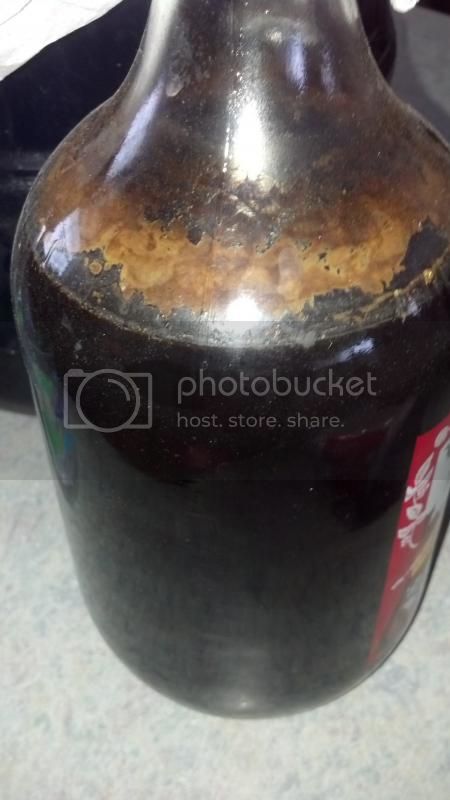
Black strap molasses is a byproduct of making sugar. It will be about half fermentable. DO NOT USE FEED MOLASSES. It's nasty, and sometimes contains unwanted chemicals. They can taste nasty, or kill yeast on contact.
Yeast is up to you, but basic bread yeast is actually a great rum yeast. It gets a buttery flavor in only a few generations. I have used many, many different yeasts and it's my #1. #2 is Belgian Abbey yeast(Wyeast 1762). You can try any yeast really.
Distilling theory
Ethanol vaporises at around 173F, water vaporises over 220F something. So we want our fermented mash to get between 173 and stay under 220 something to get out the ethanol and not the water. We then have the ethanol vapor get away from the water and touch something cool, where it will turn back into a liquid that we collect. Easy. That's basic pot-distilling 101 right there. If you want to go deeper down the rabbit hole go to homedistiller.org
My Equipment
I use a potstill to make this recipe. I have an 8 gallon boiler, and a tower that is short that goes to a leibig condenser. I can use this setup on my gas stove in my kitchen. My larger rigs are outdoors only.
Let's do this!
So the wash has finished fermenting, let's run this! I transfer the wash to the just cleaned and dried boiler and add another gallon of rotten dunder, and all the collected tails from the last generation. The tails are just more flavors to make your rum better! Sometimes I'll add a little molasses to the boiler on early generations.
Tails, wash, funked dunder
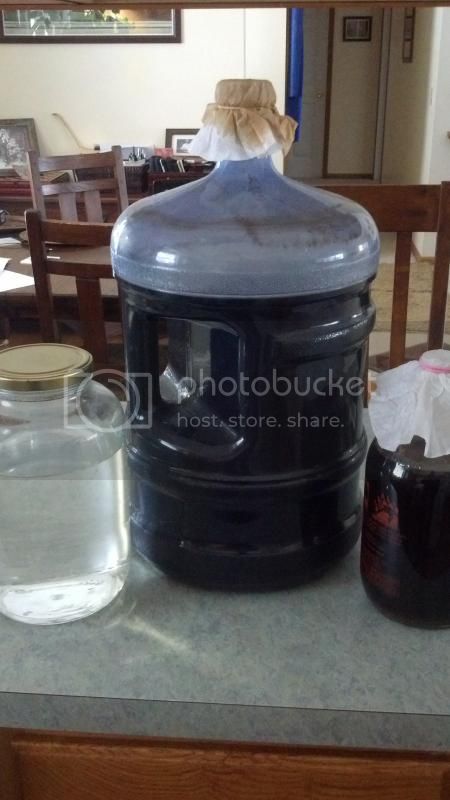
I put the boiler up on the stove, seal on the head, and connect and check all water lines BEFORE firing the gas up to high. It takes my stove about 45 mins to get up to working temps. Wonderful fruity, rummy smells will be coming out the end of the condenser as it heats up!
My crappy kitchen rig, and the thermometer on top is not used(broken years ago).
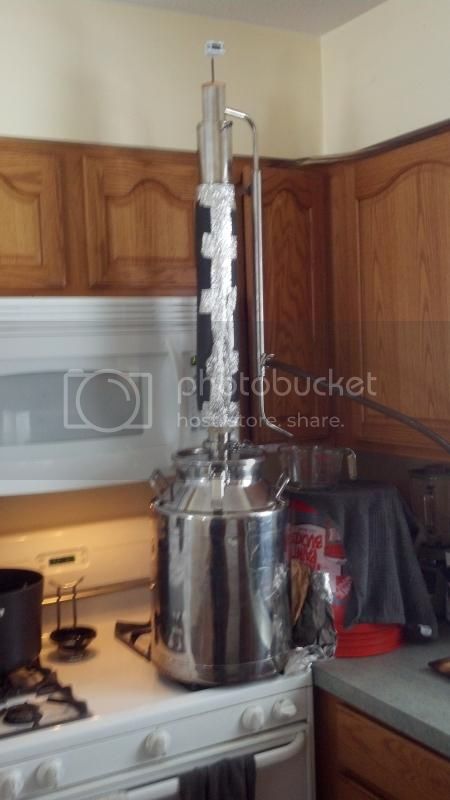
So the temps are getting close and drops start coming out before you get to 173. That's what I call "fore's". Nasty, poisons. THIS is what will make you go blind. Actetone is in there, you'll smell it. Throw these away, or into a jug for lighting bonfires. They smell like a headache, and you don't want them in your rum that you've worked so hard for. Then the temps will keep increasing and the "heads" will start coming out. Start collecting now, I collect about 100 MILS in a mason jar and cover with a coffee filter I run them at a pretty slow to medium drip to concentrate them. After a while of heads, the hearts will start coming out. THIS IS THE GOOD SHIT! I crank up the heat to get a steady stream and take samples to enjoy. Then the good times will fade into "tails". Tails aren't really bad for you, they taste and smell terrible and are low proof. Mostly water. I get a few jars of tails and the crank the heat and cooling water to as high as I can keep knocking down the vapor. I collect down to abot 15%, lower than that is just wasting fuel IMHO. The tails have good flavor that I want to keep. I collect until I'm 3-4 jars into the tails and then just collect into a big pickle jar.
You'll get this
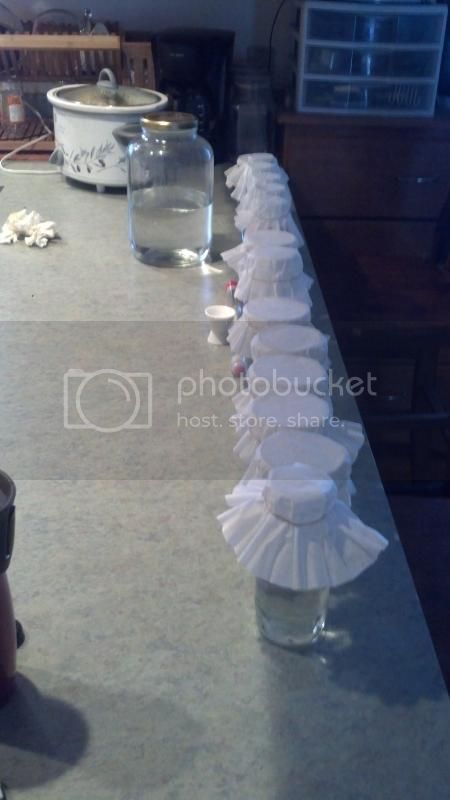
I'll leave these at least one day, a few days is better, and then make my cuts. When I'm shutting down my rig and it's still hot I prep for the next generation. I pour my 2 gallons of molasses in a pot and add a gallon of hot dunder and stir it in. I pour it into the cleaned and dried fermentor and fill to the 5.5 gallon mark with cool water, and pitch my yeast. I also pour 2 gallons into my dunder pit to replentish it.
IMPORTANT: Making my cuts
After airing out a few days it's time for a seriously important step. The cuts. This will make or break your rum. Harsh, headache causing rotgut, stinky, slimy, smells like socks.......or smooth and perfect. This is where it happens folks. This is what those "moonshiners" on tv never do, and you couldn't pay me to drink their shit. Cuts is where you eliminate the bad, and keep the good. Don't be greedy. You'll end up with a smaller amount of product, but it will beat almost anything you can buy off the shelf quality wise. And it's quality that we want, not quantity.
I start in the middle of the row of jars and start smelling them. Any that smell like heads(harsh, chemicallsy, causes hangovers), or like tails(wet socks, wet dog, wet cardboard, slippery) get eliminated. I then carefully inspect each jar to be double sure that I'm not keeping ANY amount of heads. Just one drop can ruin a whole batch. I use a shotglass. I put in a drop and fill with water and then sniff/taste. When watered down it's easier to detect heads and tails. When I'm sure that all the heads are removed, I toss them. Then it's on to the tails. More art. Some % of tails is tasty, some aren't. You decide. I usually keep them until a certain smell(poo) comes through. I then toss the rest of the tails into the pickle jar to add to the next generation run.
I add my hearts and kept tails into a large glass pitcher and begin to dilute. I have a hydrometer just like for specific gravity in beer that tells me the ABV%. I add bottled water and test until I get to my preferred "barrel proof". I use the original Admiralty proof of 114.5proof, just becase. So now I have a bunch of delicious, clean, diluted rum. PARTY TIME!!!! Nope, not even close
Aging
Now here is another art part. Aging your spirits on wood changes/develops flavors. There are a million reason and ideas why, but most do it slightly differently to give their booze it's signature flavor. I have used charred oak previously used for bourbon, and it's good. But not great. I want AMAZING, so I use toasted French oak with my rum. I just like the flavors it adds to MY RUM. I chopped my oak into stocks about the size of a crayon and add 2 to a bottle, fill with rum, and label by date. Then it goes to sleep for 5-6 months MINIMUM before I'd drink it. I do open the bottles to let them breath for a minute and to see how it's coming along. By then it turns a deep brown, and has picked up a lot of flavor from the wood and has mellowed a lot too. It's now better than almost every store bought rum.
Sit back and enjoy the fruits of your labor!
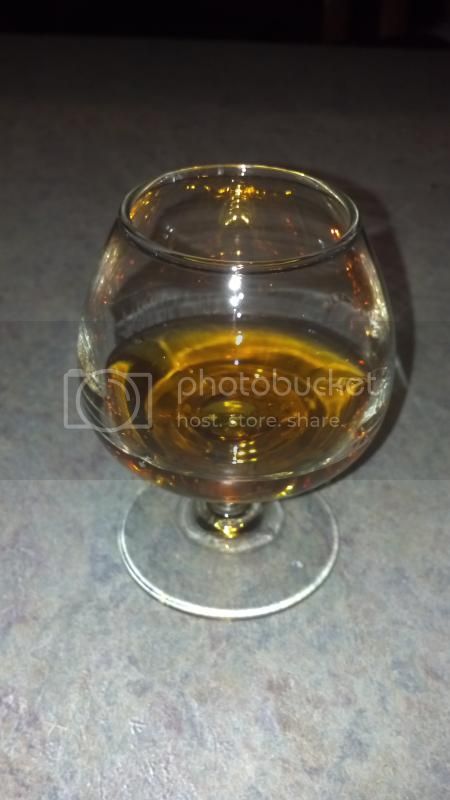
Now, this is how I make my Navy style rum. I make a lighter rum too, and do it in a very different manner. Rum is a complex spirit since the flavor is kind of hard to describe. It just tastes rummy, and you can recognise it right away. It's caused by certain esters produced during the fermentation of molasses. So really, rum tastes like rotten molasses! MMMMM...
This recipe you will end up with approximately 5 bottles of 80proof rum the first time. This recipe builds upon itself. the first time is ok, the second time it's way better, the third time will blow your socks off it's so good....on and on. I'll be describing it about 5-6 cycles, or generations, in. It's really starting to get good now!
6.5 gallon ferment
Since rum is made from fermented molasses, there isn't any mashing. No starches to convert, the sugars are already there. We make a molasses "wash" instead. A basic rum wash is simply molasses, water, and yeast. That will give you a decent final product. But I can buy decent, and since this is for fun, I want to make a MASTERPIECE!!!! So I add things to the wash to help with the ART OF RUM. I call it an art because it is an art. Hopefully you'll realise this when you read this. My Navy style rum wash(I have done it the exact same way repeatedly of years to find ways tweak and perfect it where needed) is 1 gallon fresh dunder, 2 gallons blackstrap molasses, 2 gallons water, and plain old bread yeast. I ferment at 65F, only because that's room temp in my house, until no activity for a few days. After a day or two of active fermentation I add 1 gallon aged/infected/rotten/funky DUNDER. It will not hurt it by then. Depending on many factors, this will finish around 8% abv.
I'll talk about the ingredients:
Dunder is what's left in the still boiler after a "run", or a distillation process. A run that been run effectively, and long enough, will have removed nearly all of the ethanol and a lot of the water too. What's left behind is full of concentrated flavors. It's also slightly acidic. We want those flavors! Keep it! A % of dunder added to the next generation wash will carry over flavors and make it more flavorful than the previous generation. Aged/infected/rotten/funky dunder is where the art comes into this. Outdoor dunder pits at rum distilleries in the Caribbean would rot. Someone long ago found out that like cheese, dunder is good when it's rotten. It gets perfumy, sweet smelling, and nasty looking. If it smells good, it's good. This will add to the complexity of flavor, and adds a certain flavor that some people crave. If it smells bad, throw it away!
Funky(and that's after straining it)


Black strap molasses is a byproduct of making sugar. It will be about half fermentable. DO NOT USE FEED MOLASSES. It's nasty, and sometimes contains unwanted chemicals. They can taste nasty, or kill yeast on contact.
Yeast is up to you, but basic bread yeast is actually a great rum yeast. It gets a buttery flavor in only a few generations. I have used many, many different yeasts and it's my #1. #2 is Belgian Abbey yeast(Wyeast 1762). You can try any yeast really.
Distilling theory
Ethanol vaporises at around 173F, water vaporises over 220F something. So we want our fermented mash to get between 173 and stay under 220 something to get out the ethanol and not the water. We then have the ethanol vapor get away from the water and touch something cool, where it will turn back into a liquid that we collect. Easy. That's basic pot-distilling 101 right there. If you want to go deeper down the rabbit hole go to homedistiller.org
My Equipment
I use a potstill to make this recipe. I have an 8 gallon boiler, and a tower that is short that goes to a leibig condenser. I can use this setup on my gas stove in my kitchen. My larger rigs are outdoors only.
Let's do this!
So the wash has finished fermenting, let's run this! I transfer the wash to the just cleaned and dried boiler and add another gallon of rotten dunder, and all the collected tails from the last generation. The tails are just more flavors to make your rum better! Sometimes I'll add a little molasses to the boiler on early generations.
Tails, wash, funked dunder

I put the boiler up on the stove, seal on the head, and connect and check all water lines BEFORE firing the gas up to high. It takes my stove about 45 mins to get up to working temps. Wonderful fruity, rummy smells will be coming out the end of the condenser as it heats up!
My crappy kitchen rig, and the thermometer on top is not used(broken years ago).

So the temps are getting close and drops start coming out before you get to 173. That's what I call "fore's". Nasty, poisons. THIS is what will make you go blind. Actetone is in there, you'll smell it. Throw these away, or into a jug for lighting bonfires. They smell like a headache, and you don't want them in your rum that you've worked so hard for. Then the temps will keep increasing and the "heads" will start coming out. Start collecting now, I collect about 100 MILS in a mason jar and cover with a coffee filter I run them at a pretty slow to medium drip to concentrate them. After a while of heads, the hearts will start coming out. THIS IS THE GOOD SHIT! I crank up the heat to get a steady stream and take samples to enjoy. Then the good times will fade into "tails". Tails aren't really bad for you, they taste and smell terrible and are low proof. Mostly water. I get a few jars of tails and the crank the heat and cooling water to as high as I can keep knocking down the vapor. I collect down to abot 15%, lower than that is just wasting fuel IMHO. The tails have good flavor that I want to keep. I collect until I'm 3-4 jars into the tails and then just collect into a big pickle jar.
You'll get this

I'll leave these at least one day, a few days is better, and then make my cuts. When I'm shutting down my rig and it's still hot I prep for the next generation. I pour my 2 gallons of molasses in a pot and add a gallon of hot dunder and stir it in. I pour it into the cleaned and dried fermentor and fill to the 5.5 gallon mark with cool water, and pitch my yeast. I also pour 2 gallons into my dunder pit to replentish it.
IMPORTANT: Making my cuts
After airing out a few days it's time for a seriously important step. The cuts. This will make or break your rum. Harsh, headache causing rotgut, stinky, slimy, smells like socks.......or smooth and perfect. This is where it happens folks. This is what those "moonshiners" on tv never do, and you couldn't pay me to drink their shit. Cuts is where you eliminate the bad, and keep the good. Don't be greedy. You'll end up with a smaller amount of product, but it will beat almost anything you can buy off the shelf quality wise. And it's quality that we want, not quantity.
I start in the middle of the row of jars and start smelling them. Any that smell like heads(harsh, chemicallsy, causes hangovers), or like tails(wet socks, wet dog, wet cardboard, slippery) get eliminated. I then carefully inspect each jar to be double sure that I'm not keeping ANY amount of heads. Just one drop can ruin a whole batch. I use a shotglass. I put in a drop and fill with water and then sniff/taste. When watered down it's easier to detect heads and tails. When I'm sure that all the heads are removed, I toss them. Then it's on to the tails. More art. Some % of tails is tasty, some aren't. You decide. I usually keep them until a certain smell(poo) comes through. I then toss the rest of the tails into the pickle jar to add to the next generation run.
I add my hearts and kept tails into a large glass pitcher and begin to dilute. I have a hydrometer just like for specific gravity in beer that tells me the ABV%. I add bottled water and test until I get to my preferred "barrel proof". I use the original Admiralty proof of 114.5proof, just becase. So now I have a bunch of delicious, clean, diluted rum. PARTY TIME!!!! Nope, not even close

Aging
Now here is another art part. Aging your spirits on wood changes/develops flavors. There are a million reason and ideas why, but most do it slightly differently to give their booze it's signature flavor. I have used charred oak previously used for bourbon, and it's good. But not great. I want AMAZING, so I use toasted French oak with my rum. I just like the flavors it adds to MY RUM. I chopped my oak into stocks about the size of a crayon and add 2 to a bottle, fill with rum, and label by date. Then it goes to sleep for 5-6 months MINIMUM before I'd drink it. I do open the bottles to let them breath for a minute and to see how it's coming along. By then it turns a deep brown, and has picked up a lot of flavor from the wood and has mellowed a lot too. It's now better than almost every store bought rum.
Sit back and enjoy the fruits of your labor!


